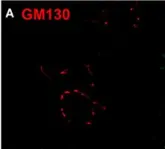Epithelial-to-mesenchymal transition (EMT) underlies immunosuppression, drug resistance, and metastasis in epithelial malignancies. However, the way in which EMT orchestrates disparate biological processes remains unclear. Here, we identify an EMT-activated vesicular trafficking network that coordinates promigratory focal adhesion dynamics with an immunosuppressive secretory program in lung adenocarcinoma (LUAD). The EMT-activating transcription factor ZEB1 drives exocytotic vesicular trafficking by relieving Rab6A, Rab8A, and guanine nucleotide exchange factors from miR-148a-dependent silencing, thereby facilitating MMP14-dependent focal adhesion turnover in LUAD cells and autotaxin-mediated CD8+ T cell exhaustion, indicating that cell-intrinsic and extrinsic processes are linked through a microRNA that coordinates vesicular trafficking networks. Blockade of ZEB1-dependent secretion reactivates antitumor immunity and negates resistance to PD-L1 immune checkpoint blockade, an important clinical problem in LUAD. Thus, EMT activates exocytotic Rabs to drive a secretory program that promotes invasion and immunosuppression in LUAD.
Product Citations: 9
EMT activates exocytotic Rabs to coordinate invasion and immunosuppression in lung cancer.
In Proceedings of the National Academy of Sciences of the United States of America on 11 July 2023 by Xiao, G. Y., Tan, X., et al.
-
Cancer Research
The CD58-CD2 axis is co-regulated with PD-L1 via CMTM6 and shapes anti-tumor immunity.
In Cancer Cell on 10 July 2023 by Ho, P., Melms, J. C., et al.
The cell-autonomous balance of immune-inhibitory and -stimulatory signals is a critical process in cancer immune evasion. Using patient-derived co-cultures, humanized mouse models, and single-cell RNA-sequencing of patient melanomas biopsied before and on immune checkpoint blockade, we find that intact cancer cell-intrinsic expression of CD58 and ligation to CD2 is required for anti-tumor immunity and is predictive of treatment response. Defects in this axis promote immune evasion through diminished T cell activation, impaired intratumoral T cell infiltration and proliferation, and concurrently increased PD-L1 protein stabilization. Through CRISPR-Cas9 and proteomics screens, we identify and validate CMTM6 as critical for CD58 stability and upregulation of PD-L1 upon CD58 loss. Competition between CD58 and PD-L1 for CMTM6 binding determines their rate of endosomal recycling over lysosomal degradation. Overall, we describe an underappreciated yet critical axis of cancer immunity and provide a molecular basis for how cancer cells balance immune inhibitory and stimulatory cues.
Copyright © 2023 Elsevier Inc. All rights reserved.
-
Cancer Research
-
Immunology and Microbiology
Analysis of Golgi Secretory Functions in Cancer.
In Methods in Molecular Biology (Clifton, N.J.) on 14 December 2022 by Banerjee, P., Tan, X., et al.
Cancer cells utilize secretory pathways for paracrine signaling and extracellular matrix remodeling to facilitate directional cell migration, invasion, and metastasis. The Golgi apparatus is a central secretory signaling hub that is often deregulated in cancer. Here we described technologies that utilize microscopic, biochemical, and proteomic approaches to analyze Golgi secretory functions in genetically heterogeneous cancer cell lines.
© 2023. The Author(s), under exclusive license to Springer Science+Business Media, LLC, part of Springer Nature.
-
Biochemistry and Molecular biology
-
Cancer Research
-
Cell Biology
In Cell Reports on 27 September 2022 by Bajaj, R., Rodriguez, B. L., et al.
Lung cancer is a highly aggressive and metastatic disease responsible for approximately 25% of all cancer-related deaths in the United States. Using high-throughput in vitro and in vivo screens, we have previously established Impad1 as a driver of lung cancer invasion and metastasis. Here we elucidate that Impad1 is a direct target of the epithelial microRNAs (miRNAs) miR-200 and miR∼96 and is de-repressed during epithelial-to-mesenchymal transition (EMT); thus, we establish a mode of regulation of the protein. Impad1 modulates Golgi apparatus morphology and vesicular trafficking through its interaction with a trafficking protein, Syt11. These changes in Golgi apparatus dynamics alter the extracellular matrix and the tumor microenvironment (TME) to promote invasion and metastasis. Inhibiting Impad1 or Syt11 disrupts the cancer cell secretome, regulates the TME, and reverses the invasive or metastatic phenotype. This work identifies Impad1 as a regulator of EMT and secretome-mediated changes during lung cancer progression.
Copyright © 2022 The Authors. Published by Elsevier Inc. All rights reserved.
-
Cancer Research
Human monocytes store and secrete preformed CCL5, independent of de novo protein synthesis.
In Journal of Leukocyte Biology on 1 March 2022 by Persaud, A. T., Bennett, S. A., et al.
Monocytes are a subset of circulating peripheral blood mononuclear cells with diverse roles in immunity, including sentinel roles in cytokine secretion. Conventionally, cytokines require an inductive stimulus for their expression and secretion, resulting in a time lag from the time of stimulation to when the proteins are packaged and secreted. Because cytokines are the main communicators in the immune system, their temporal expression is a key factor in coordinating responses to efficiently resolve infection. Herein, we identify that circulating human monocytes contain preformed cytokines that are stored intracellularly, in both resting and activated states. Having preformed cytokines bypasses the time lag associated with de novo synthesis, allowing monocytes to secrete immune mediators immediately upon activation or sensing of microbe-associated molecular patterns. We demonstrate here that, out of several cytokines evaluated, human monocytes contain a previously undescribed reservoir of the preformed chemokine CCL5. Furthermore, we showed that CCL5 could be secreted from monocytes treated with the protein synthesis inhibitor (cycloheximide) and Golgi blocker (brefeldin A). We examined the possibility for uptake of extracellular CCL5 from platelet aggregates and observed no significant levels of platelet binding to our enriched monocyte preparations, indicating that the source of preformed CCL5 was not from platelets. Preformed CCL5 was observed to be distributed throughout the cytoplasm and partially colocalized with CD63+ and Rab11A+ membranes, implicating endosomal compartments in the intracellular storage and trafficking of CCL5.
©2021 Society for Leukocyte Biology.
-
Immunology and Microbiology
In Front Mol Neurosci on 14 August 2012 by Maj, M., Milenković, I., et al.
Fig.6.A

-
IHC-IF
-
Rattus norvegicus (Rat)
Collected and cropped from Front Mol Neurosci by CiteAb, provided under a CC-BY license
Image 1 of 1
